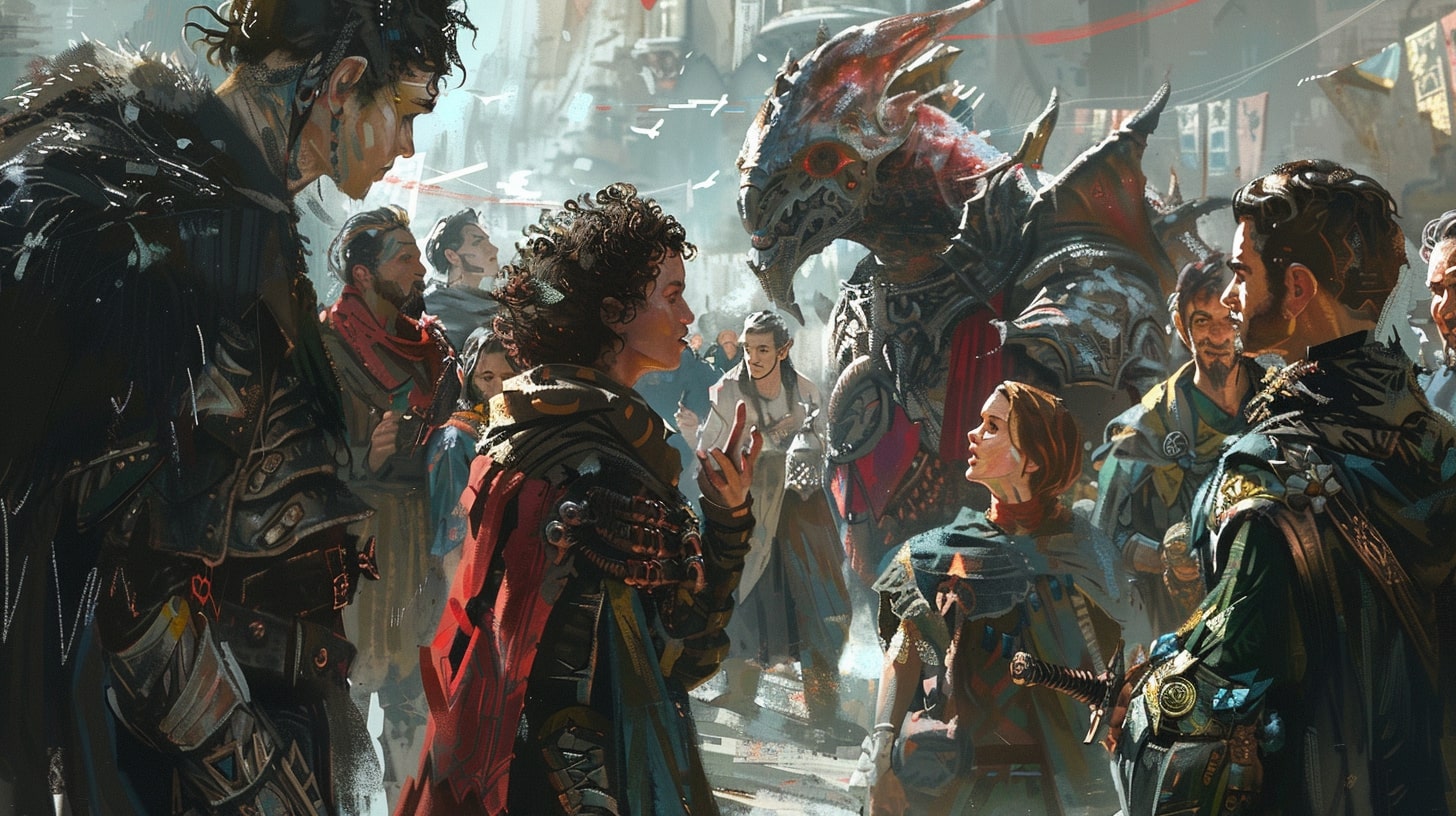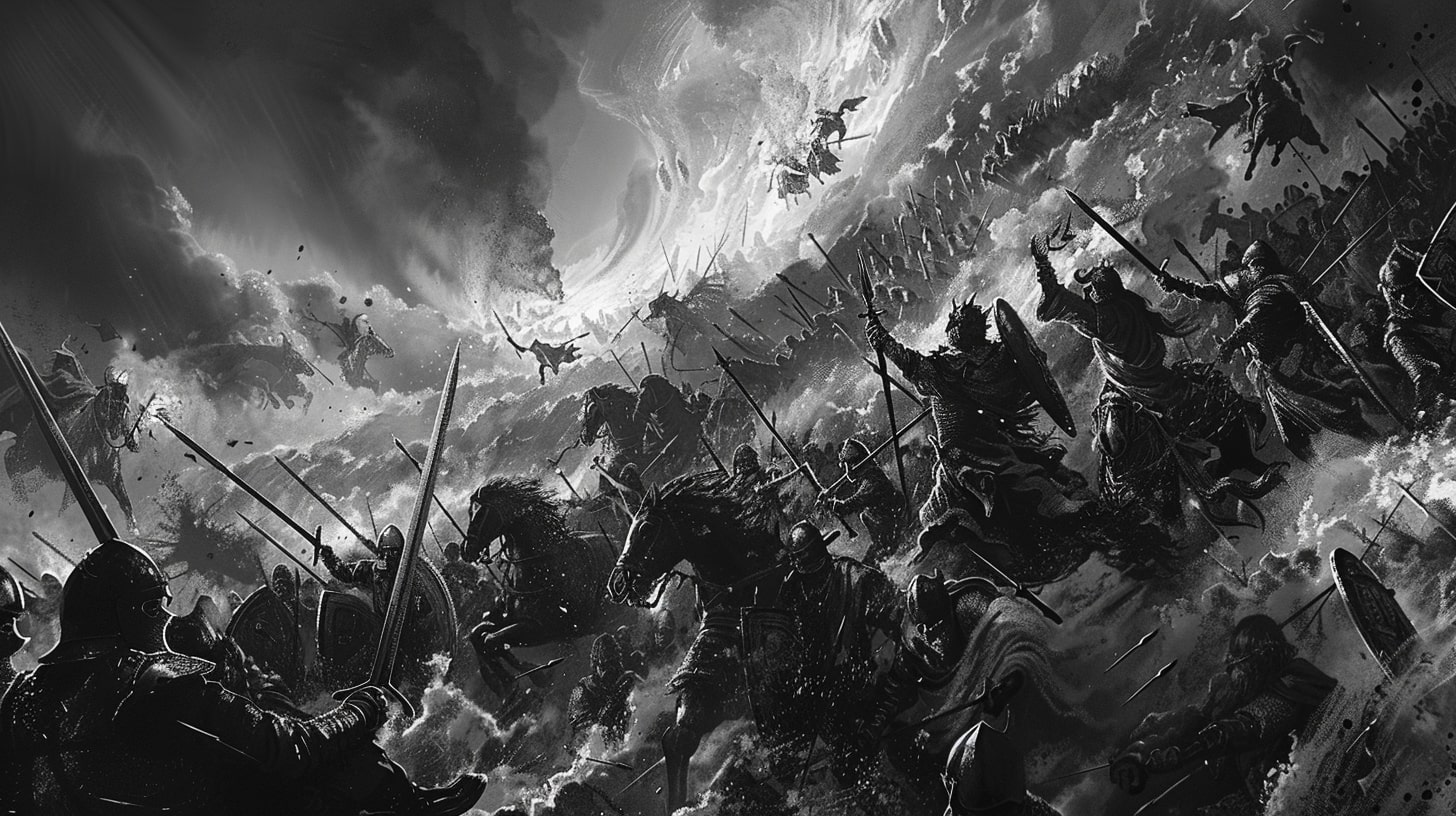Mastering Fantasy Dialogue
When it comes to writing captivating fantasy fiction, mastering the art of dialogue is essential. Dialogue plays a crucial role in bringing your characters to life and driving the plot forward.
The last thing you want to do is bore your readers because they are reading dialogue that doesn’t appeal to them. So how do you go about writing fantasy dialogue that doesn’t put people to sleep?
That’s what we’re going to dive into in this post to make sure that your fantasy writing isn’t subpar.
The Importance of Dialogue in Fantasy Writing
Dialogue serves as a powerful tool for character development and storytelling in fantasy writing. Through dialogue, you can reveal your characters’ personalities, motivations, and conflicts. It allows readers to connect with the characters on a deeper level and become emotionally invested in their journey.
In the realm of fantasy, where the possibilities are endless, dialogue helps to establish the rules and dynamics of the fantastical world you’ve created. It allows you to introduce magic systems, lore, and cultural nuances through the conversations between characters. By crafting authentic and engaging dialogue, you can immerse your readers in the rich tapestry of your fantasy realm.
To make your dialogue shine, it’s important to strike a balance between authenticity and accessibility. While it’s tempting to create elaborate and complex dialogue, it’s crucial to ensure that it remains understandable and relatable to your readers.
Avoid using overly convoluted language or excessive jargon that might alienate your audience. Instead, focus on crafting dialogue that feels natural and true to the characters and the world you’ve created.
Setting the Stage: Creating a Vibrant Fantasy World
In fantasy writing, the setting is as much a character as the individuals who inhabit it. To create a vibrant fantasy world, you need to pay attention to the details and imagery you infuse into your descriptions. Your dialogue should reflect the unique aspects of the world you’ve built.
Consider the language your characters use. Are there specific terms or phrases that are unique to their culture or magic system? Do different regions or species have distinct accents or speech patterns? By incorporating these nuances into your dialogue, you can add depth and authenticity to your fantasy world.
Additionally, think about the social structures and power dynamics at play in your world. How do these influence the way characters communicate with each other? Are there certain rules or protocols that govern their interactions? Reflecting these elements in your dialogue can enhance the immersion and believability of your fantasy world.
Remember to use descriptive language to create vivid imagery in your dialogue. This can help bring the fantastical elements of your world to life. Whether it’s describing the shimmering glow of a magical spell or the majestic landscapes of your fantasy realm, effective use of descriptive language can transport your readers into the heart of your story.
By understanding the importance of dialogue in fantasy writing and creating a vibrant fantasy world, you can elevate your storytelling and captivate readers with your imaginative tales. Now, let’s delve deeper into the techniques and strategies for crafting engaging fantasy dialogue.

Understanding Fantasy Dialogue
When it comes to writing captivating fantasy dialogue, there are a few key aspects to consider. Understanding how to balance authenticity with accessibility and establishing unique voices for your characters are essential elements that will bring your fantasy world to life.
Balancing Authenticity and Accessibility
While it’s important to create a sense of authenticity in your fantasy dialogue, it’s equally crucial to ensure that it remains accessible to your readers. Authenticity can be achieved by incorporating elements of the fantastical world you’ve created, such as unique vocabulary, cultural references, or idioms specific to your fantasy realm.
However, it’s important to strike a balance so that readers can easily understand and engage with the dialogue. Avoid overwhelming your readers with an abundance of unfamiliar terms or complex language. Instead, use context cues and provide explanations when necessary to help readers navigate your fantastical world.
Establishing Unique Voices for Characters
To make your fantasy dialogue truly captivating, it’s essential to establish unique voices for each of your characters. Each character should have their own distinct way of speaking, reflecting their personality, background, and experiences.
Consider factors such as their education level, social status, and cultural influences when crafting their dialogue. A character from a noble background may speak with grace and formality, while a street urchin may use slang or have a rougher tone. These nuances in speech patterns and vocabulary will help differentiate your characters and make them feel more authentic.
By giving each character a unique voice, you can create more dynamic and engaging interactions between them. This will also help your readers easily identify and connect with each character on a deeper level.
Understanding the importance of balancing authenticity and accessibility in fantasy dialogue, as well as establishing unique voices for your characters, will elevate your writing and immerse readers in the vibrant world you’ve created. Experiment with different dialogue techniques, and don’t be afraid to seek feedback from other writers or beta readers to refine and polish your fantasy dialogue further.

Writing Fantasy Dialogue: Crafting Something Engaging
To write captivating fantasy dialogue, it’s important to focus on two key aspects: revealing character traits and incorporating worldbuilding. By mastering these techniques, you can bring your fantasy world to life and create memorable and authentic dialogue for your characters.
Show, Don’t Tell: Using Dialogue to Reveal Character Traits
In fantasy writing, dialogue serves as a powerful tool for revealing character traits. Instead of directly telling readers about a character’s personality, let their words and interactions speak for themselves. Each character should have a unique voice that reflects their background, beliefs, and motivations.
Through dialogue, you can showcase a character’s wit, humor, intelligence, or even their flaws and vulnerabilities. Consider their speech patterns, vocabulary, and idioms, which can be influenced by their social status, culture, or even the magical elements of your world. This differentiation in dialogue helps to make each character distinct and adds depth to their interactions.
For example, a wise and experienced wizard may speak in a formal and eloquent manner, while a street-smart rogue might use slang and have a sarcastic tone. By paying attention to these nuances, you can create dialogue that not only moves the story forward but also reveals the essence of your characters.
Incorporating Worldbuilding through Dialogue
Dialogue provides an excellent opportunity to incorporate worldbuilding elements seamlessly into your narrative. Through conversations between characters, you can introduce the unique aspects of your fantasy world, such as its history, magic system, or societal structures.
Consider how characters discuss their everyday lives, traditions, or even the creatures and cultures that inhabit your world. By using dialogue to convey this information, you avoid lengthy exposition and engage readers in a more immersive way.
For example, during a conversation, characters can mention ancient prophecies, refer to mythical creatures, or discuss the intricacies of the magical spells they use. This not only adds depth to your world but also makes the dialogue more interesting and relevant to the story.
Remember to strike a balance between providing information and keeping the dialogue natural and engaging. Avoid overwhelming readers with excessive details and focus on integrating worldbuilding seamlessly into the conversation.
By utilizing dialogue to reveal character traits and incorporate worldbuilding, you can create engaging and immersive fantasy dialogue. These techniques allow readers to connect with your characters on a deeper level and fully immerse themselves in your fantastical world.

Techniques for Writing Compelling Fantasy Dialogue
To write captivating fantasy dialogue, it’s important to employ certain techniques that bring your characters and their conversations to life. Here are two key techniques that can enhance the effectiveness of your fantasy dialogue: using imagery and descriptive language and utilizing subtext and foreshadowing.
Using Imagery and Descriptive Language
Imagery and descriptive language play a vital role in creating a vivid and immersive fantasy world. By incorporating rich and evocative descriptions into your characters’ dialogue, you can transport readers to the fantastical realms you’ve envisioned.
When crafting dialogue, consider how your characters perceive and interact with their surroundings. Encourage them to use sensory details to describe what they see, hear, smell, taste, and touch. By painting a picture with words, you engage the readers’ imagination and make the scene come alive.
For example, instead of simply stating that a character enters a room, you can have them describe the room’s atmosphere, such as the flickering candlelight casting dancing shadows on the ancient stone walls. This not only sets the mood but also provides visual cues that enhance the reader’s experience.
By weaving imagery and descriptive language into your fantasy dialogue, you create a more immersive and captivating reading experience. Remember to strike a balance between dialogue and descriptions, ensuring that they complement each other to propel the story forward. For more tips on writing fantasy fiction, check out our article on how to write fantasy novels.
Utilizing Subtext and Foreshadowing
Subtext and foreshadowing add depth and intrigue to your fantasy dialogue, allowing readers to uncover hidden meanings and anticipate future events. Subtext refers to the underlying messages or emotions conveyed indirectly through dialogue, while foreshadowing hints at future plot developments.
To incorporate subtext into your dialogue, consider what your characters are not saying explicitly. Use their words, tone, and actions to imply deeper motivations, conflicts, or secrets. This adds complexity to their interactions and keeps readers engaged as they unravel the layers of meaning.
Foreshadowing, on the other hand, plants subtle clues or hints within the dialogue that will become significant later in the story. These hints can create anticipation and build suspense, as readers try to piece together the puzzle. For example, a seemingly innocuous conversation about a long-lost prophecy might foreshadow a major plot twist or a character’s destiny.
By skillfully utilizing subtext and foreshadowing in your fantasy dialogue, you create intrigue and suspense, keeping readers hooked and eager to uncover the hidden truths within your story. For more tips on writing captivating dialogue, check out our article on writing fantasy dialogue.
Remember, crafting compelling fantasy dialogue is an art that requires practice and careful consideration. Experiment with these techniques to breathe life into your characters and immerse readers in the enchanting worlds you’ve created.
Common Pitfalls to Avoid in Fantasy Dialogue
When writing fantasy dialogue, it’s important to be aware of common pitfalls that can hinder the effectiveness and believability of your dialogue. By avoiding these pitfalls, you can ensure that your dialogue remains engaging and authentic to your fantasy world. Two common pitfalls to watch out for are info-dumping through dialogue and overusing exposition and speech tags.
Info-dumping through Dialogue
Info-dumping occurs when an excessive amount of information is delivered all at once, often overwhelming readers with unnecessary details.
This is particularly problematic when it happens through dialogue, as it can feel forced and unnatural. Instead of dumping large amounts of information through dialogue, opt for a more subtle and organic approach to worldbuilding.
Rather than having characters explain everything to each other, consider integrating worldbuilding details into the narrative itself. Show readers the world through visual descriptions, character actions, and interactions with the environment.
This will help immerse readers in your fantasy world without overwhelming them with a barrage of information.
Remember, dialogue should primarily serve the purpose of advancing the plot and revealing character traits. Use it sparingly for worldbuilding purposes, focusing on meaningful exchanges that contribute to the story’s progression.
Overusing Exposition and Speech Tags
Exposition refers to the background information necessary to understand the story. While some exposition is essential, overusing it in dialogue can make conversations feel unnatural and stilted. Avoid lengthy explanations and unnecessary details that slow down the pace of the conversation.
Similarly, overusing speech tags—such as “he said,” “she exclaimed,” or “they whispered”—can become distracting and repetitive. Instead, strive for a balance between clarity and variety.
When it’s clear who is speaking, you can omit speech tags altogether or replace them with action beats to indicate who is talking. This helps maintain a smooth flow of dialogue and avoids unnecessary interruptions.
Consider the following example:
Excessive speech tags:
“I can’t believe we’re finally embarking on this perilous journey,” John exclaimed.
“Yes, it’s quite an adventure,” Mary replied.
“Indeed, we must be cautious,” John cautioned.
Improved version with action beats:
John’s eyes widened as he spoke. “I can’t believe we’re finally embarking on this perilous journey.”
Mary nodded, a glimmer of excitement in her eyes. “Yes, it’s quite an adventure.”
John tightened his grip on his sword. “Indeed, we must be cautious.”
By using action beats, you can convey information about the characters’ emotions and actions while keeping the dialogue flowing naturally.
Remember, the key is to make your dialogue feel organic and true to the characters and world you’ve created. By avoiding info-dumping and overusing exposition and speech tags, you can create dialogue that captivates readers and enhances the immersive experience of your fantasy world.
Polishing Your Fantasy Dialogue
Once you have crafted your fantasy dialogue, it’s time to polish it through the process of editing and revising. This stage is crucial in refining your dialogue and ensuring that it effectively captivates your readers. Here are some key steps to consider:
Editing and Revising Dialogue
During the editing phase, carefully review your dialogue with a critical eye. Look for areas where the dialogue can be improved, such as eliminating unnecessary exposition or tightening the pacing. Pay attention to the following aspects:
Consistency of Character Voices: Ensure that each character’s dialogue remains consistent with their established personality, speech patterns, and cultural background. This consistency contributes to creating believable and relatable characters.
Dialogue Tags and Attribution: Evaluate the use of dialogue tags (e.g., “he said,” “she replied”) and attribution. Avoid overusing speech tags, as excessive attribution can become distracting. Instead, strive to incorporate action beats and non-verbal cues to indicate which character is speaking.
Readability: Consider the flow and readability of your dialogue. Break up long speeches into smaller chunks to maintain reader engagement. Vary sentence lengths and use natural pauses to mimic realistic conversation.
Subtext and Nuance: Examine your dialogue for opportunities to include subtext and nuance. Subtext adds depth to your characters’ interactions by conveying underlying emotions, motives, or hidden meanings. This can create intrigue and tension in your story.
Dialogue Length: Assess the length of your dialogue exchanges. Long dialogue passages can become monotonous, while short and snappy exchanges can quicken the pace. Strive for a balance that suits the tone and rhythm of your narrative.
Seeking Feedback and Beta Readers
After editing and revising your fantasy dialogue, it’s beneficial to seek feedback from others. Beta readers, fellow writers, or writing groups can provide valuable insights and fresh perspectives on your dialogue. Consider sharing specific scenes or excerpts to gather feedback on the effectiveness of your dialogue.
When seeking feedback, ask specific questions to guide the reviewers’ focus. Inquire about the clarity of character voices, the impact of the dialogue on the overall narrative, and any areas that may require further improvement. Be open to constructive criticism and use it to refine your dialogue further.
Remember, the process of polishing your fantasy dialogue is an ongoing one. Continuously review and revise your dialogue as you progress through your writing journey. By honing your skills and incorporating feedback, you can create captivating and authentic dialogue that elevates your fantasy storytelling.
For more tips on various aspects of fiction writing, including fantasy and sci-fi, check out our other articles on how to write fantasy novels, fantasy writing tips, and crafting sci-fi plots.




































